![[Image of the book's cover unavailable.]](images/cover.jpg)
Title: Tennyson
Author: G. K. Chesterton
Richard Garnett
Release date: April 6, 2020 [eBook #61764]
Most recently updated: October 17, 2024
Language: English
Credits: Produced by Tim Lindell, Chuck Greif and the Online
Distributed Proofreading Team at https://www.pgdp.net (This
file was produced from images generously made available
by The Internet Archive/American Libraries.)
![[Image of the book's cover unavailable.]](images/cover.jpg)
|
Tennyson List of Illustrations Tennyson as an Intellectual Force (etext transcriber's note) |
BY
G. K. CHESTERTON
AND
DR. RICHARD GARNETT, C.B.
WITH NUMEROUS ILLUSTRATIONS
NEW YORK
JAMES POTT AND COMPANY
LONDON
HODDER AND STOUGHTON
{ii}
PRINTED BY
HAZELL, WATSON AND VINEY, LD.
LONDON AND AYLESBURY
ENGLAND.
{iii}
IT was merely the accident of his hour, the call of his age, which made Tennyson a philosophic poet. He was naturally not only a pure lover of beauty, but a pure lover of beauty in a much more peculiar and distinguished sense even than a man like Keats, or a man like Robert Bridges. He gave us scenes of Nature that cannot easily be surpassed, but he chose them like a landscape painter rather than like a religious poet. Above all, he exhibited his abstract love of the beautiful in one most personal and characteristic fact. He was never so successful or so triumphant as when he was describing not Nature, but art. He could describe a statue as Shelley could describe a cloud. He was at his very best in describing buildings, in their blending of aspiration and exactitude. He found to perfection the harmony between the rhythmic recurrences of poetry and the rhythmic recurrences of architecture. His description, for example, of the Palace of Art is a thing entirely victorious and unique. The whole edifice, as{2}
described, rises as lightly as a lyric, it is full of the surge of the hunger for beauty; and yet a man might almost build upon the description as upon the plans of an architect or the instructions of a speculative builder. Such a lover of beauty was Tennyson, a lover of beauty most especially where it is most to be found, in the works of man. He loved beauty in its completeness, as we find it in art, not in its more glorious incompleteness as we{3}
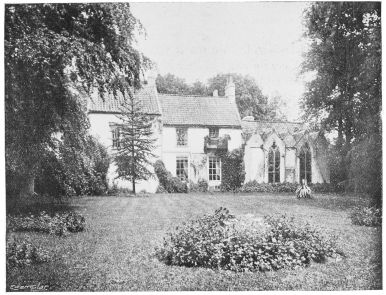
From a photo by Messrs. Carlton & Sons, Horncastle
SOMERSBY RECTORY, LINCOLNSHIRE
Where Alfred Tennyson was born, on Sunday, August 6th, 1809
find it in Nature. There is, perhaps, more loveliness in Nature than in art, but there are not so many lovely things. The loveliness is broken to pieces and scattered: the almond tree in blossom will have a mob of nameless insects at its root, and the most perfect cell in the great forest-house is likely enough to smell like a sewer. Tennyson loved beauty more in its collected form in art, poetry, and sculpture; like his own “Lady of Shalott,” it was his office to look rather at the mirror than at the object. He was an artist, as it were, at two removes: he was a splendid imitator of the splendid imitations. It is true that his natural history was exquisitely exact, but natural history and natural{4} religion are things that can be, under certain circumstances, more unnatural than anything in the world. In reading Tennyson’s natural descriptions we never seem to be in physical contact with the earth. We learn nothing of the coarse good-temper and rank energy of life. We see the whole scene accurately, but we see it through glass. In Tennyson’s works we see Nature indeed, and hear Nature, but we do not smell it.
But this poet of beauty and a certain magnificent idleness lived at a time when all men had to wrestle and decide. It is not easy for any person who lives in our time, when the dust has settled and the spiritual perspective has been restored, to realise what the entrance of the idea of evolution meant for the men of those days. To us it is a discovery of another link in a chain which, however far we follow it, still stretches back into a divine mystery. To{5}
many of the men of that time it would appear from their writings that it was the heart-breaking and desolating discovery of the end and origin of the chain. To them had happened the most black and hopeless catastrophe conceivable to human nature; they had found a logical explanation of all things. To them it seemed that an Ape had suddenly risen to gigantic stature and destroyed the seven heavens. It is difficult, no doubt, for us{6}
in somewhat subtler days to understand how anybody could suppose that the origin of species had anything to do with the origin of being. To us it appears that to tell a man who asks who made his mind that evolution made it, is like telling a man who asks who rolled a cab-wheel over his leg that revolution rolled it. To state the process is scarcely to state the agent. But the position of those who regarded the opening of the “Descent of Man” as the opening of one of the seals of the last days, is a great deal sounder than people have generally allowed. It has been constantly supposed that they were angry with Darwinism because it appeared to do something or other to the Book of Genesis; but this was a pretext or a fancy. They fundamentally rebelled against Darwinism, not because they had a fear that it would affect Scripture, but because they had a fear, not altogether unreasonable or ill-founded, that it would affect morality. Man had been engaged, through innumerable ages, in a struggle with sin. The evil within him was as strong as he could cope{7}

ALFRED TENNYSON, 1838
From an early Daguerreotype
(Reproduced from “Tennyson: a Memoir,” by kind permission of Messrs. Macmillan & Co., Ltd.)
Engraved by G. J. Stodart
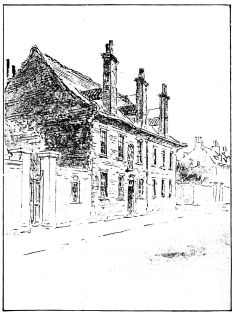
OLD GRAMMAR SCHOOL, LOUTH
The original building, now no longer in existence, where Tennyson was sent to school at the age of seven
(Reproduced from “The Laureate’s Country,” by kind permission of Messrs. Seeley & Co., Ltd.)
From a drawing by E. Hull
with—it was as powerful as a cannonade and as enchanting as a song. But in this struggle he had always had Nature on his side. He might be polluted and agonised, but the flowers were innocent and the hills were strong. All the armoury of life, the spears of the pinewood and the batteries of the lightning, went into battle beside him. Tennyson lived in the hour when, to all mortal appearance, the whole of the physical world deserted to the devil. The universe, governed by violence and death, left man to fight alone, with a handful of myths and memories. Men had now to wander in polluted fields and lift up their eyes to abominable hills. They had to arm themselves against the cruelty of flowers and the crimes of the grass. The first honour, surely, is to those who did not faint in the face of that confounding{8}
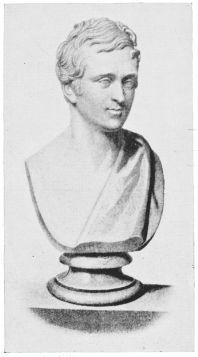
From the bust by Chantrey
ARTHUR H. HALLAM
(Reproduced from Hallam’s “Remains,” by kind permission of Mr. John Murray)
cosmic betrayal; to those who sought and found a new vantage-ground for the army of Virtue. Of these was Tennyson, and it is surely the more to his honour, since he was the idle lover of beauty of whom we have spoken. He felt that the time called him to be an interpreter. Perhaps he might even have been something more of a poet if he had not sought to be something more than a poet. He might have written a more perfect Arthurian epic if his heart had been as much buried in prehistoric sepulchres as the heart of Mr. W. B. Yeats. He might have made more of such poems as “The Golden Year” if his mind had been as clean of metaphysics and as full of a poetic rusticity as the mind of William Morris. He might have been a greater poet if he had been less a man of his dubious and rambling age. But there are some things that are greater than greatness; there are some things that no man with blood in his body would sell for the throne of Dante, and one of them is to fire the feeblest shot in a war that really awaits decision, or carry the meanest musket in an army that is really marching by. Tennyson may even have forfeited immortality: but he and the men of his age were more than immortal; they were alive.{9}
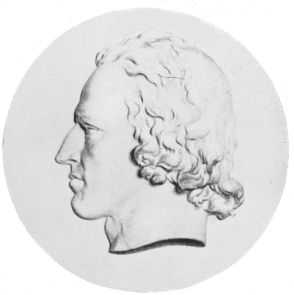
From the medallion by Thomas Woolner, R.A.
ALFRED TENNYSON
(Reproduced from “Tennyson’s Poems,” by kind permission of Messrs. Macmillan & Co., Ltd.)
Tennyson had not a special talent for being a philosophic poet, but he had a special vocation for being a philosophic poet. This may seem a contradiction, but it is only because all the Latin or Greek words we use tend endlessly to lose their meaning. A vocation is supposed to mean merely a taste or faculty, just as economy is held to mean merely the act of saving. Economy means the management of a house or community. If a man starves his best horse, or causes his best workman to strike for more pay, he is not merely unwise, he is uneconomical. So it is with a vocation. If this country were suddenly invaded by some huge alien and conquering population, we should all be called to become soldiers. We should not think in that time that we were sacrificing our unfinished work on Cattle-Feeding or our hobby of fretwork, our brilliant career at the Bar or our taste for painting in water-colours. We should all have a call to arms. We should, however, by no means agree that we{10} all had a vocation for arms. Yet a vocation is only the Latin for a call.
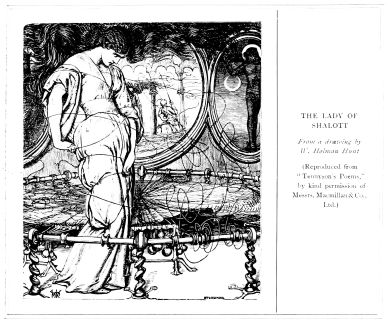
THE LADY OF SHALOTT
From a drawing by W. Holman Hunt
(Reproduced from “Tennyson’s Poems,” by kind permission of Messrs. Macmillan & Co., Ltd.)
In a celebrated passage in “Maud,” Tennyson praised the moral effects of war, and declared that some great conflict might call out the greatness even of the pacific swindlers and sweaters whom he saw around him in the Commercial age. He dreamed, he said, that if—
Tennyson lived in the time of a conflict more crucial and frightful{11} than any European struggle, the conflict between the apparent artificiality of morals and the apparent immorality of science. A ship more symbolic and menacing than any foreign three-decker hove in sight in that time—the great, gory pirate-ship of Nature, challenging all the civilisations of the world. And his supreme honour is this, that he behaved like his own imaginary snub-nosed rogue. His honour is that in that hour he despised the flowers and embroideries of Keats as the counter-jumper might despise his tapes and cottons. He was by nature a hedonistic and pastoral poet, but he leapt from his poetic counter and till and struck, were it but with his gimcrack mandolin, home.
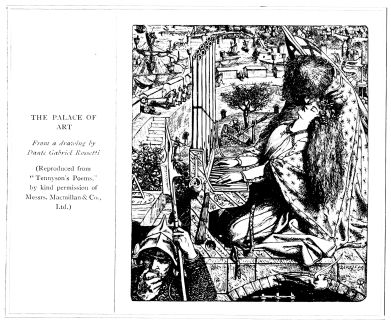
THE PALACE OF ART
From a drawing by Dante Gabriel Rossetti
(Reproduced from “Tennyson’s Poems,” by kind permission of Messrs. Macmillan & Co., Ltd.)
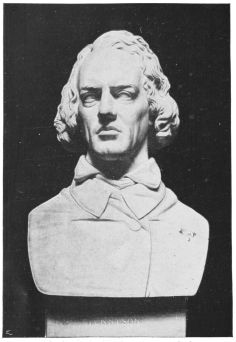
ALFRED TENNYSON
A marble bust, copied by Miss Grant from the original, sculptured from life in 1857 by Thomas Woolner, R.A.
Rischgitz Collection
Tennyson’s influence on poetry may, for a time, be modified. This is the fate of every man who throws himself into his own age, catches the echo of its temporary phrases, is kept busy in battling with its temporary delusions. There are many men whom history has for a time forgotten to whom it owes more than it could count. But if Tennyson is extinguished it will be with the most glorious extinction. There are two ways in which a man may vanish—through being thoroughly conquered or through being thoroughly the Conqueror. In the main, the great Broad Church philosophy which Tennyson uttered has been adopted by every one. This will make against his fame. For a man may vanish as Chaos vanished in the face of creation, or he may vanish as God vanished in filling all things with that created life.
G. K. Chesterton.
{13}
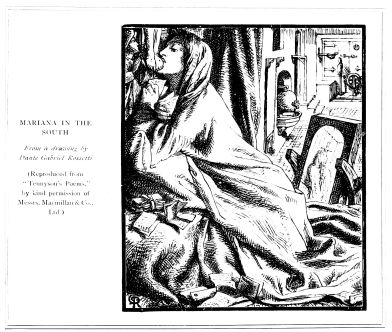
MARIANA IN THE SOUTH
From a drawing by Dante Gabriel Rossetti
(Reproduced from “Tennyson’s Poems,” by kind permission of Messrs. Macmillan & Co., Ltd.)
IT is easy to exaggerate, and equally easy to underrate, the influence of Tennyson on his age as an intellectual force. It will be exaggerated if we regard him as a great original mind, a proclaimer or revealer of novel truth. It will be underrated if we overlook the great part reserved for him who reveals, not new truth to the age, but the age to itself, by presenting it with a{14}
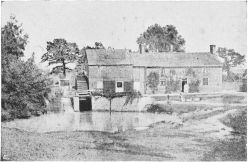
STOCKWORTH MILL
(Reproduced from “The Homes and Haunts of Alfred, Lord Tennyson,” by kind permission of Mr. George G. Napier and Messrs. James Maclehose & Sons)
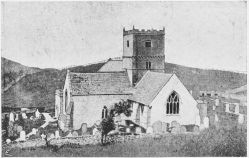
CLEVEDON CHURCH
Where the remains of Arthur Hallam were finally laid to rest on January 3rd, 1834.
(Reproduced from “The Homes and Haunts of Alfred, Lord Tennyson,” by kind permission of Mr. George G. Napier and Messrs. James Maclehose & Sons)
miniature of its own highest, and frequently unconscious, tendencies and aspirations. Not Dryden or Pope were more intimately associated with their respective ages than Tennyson with that brilliant period to which we now look back as the age of Victoria. His figure cannot, indeed, be so dominant as theirs. The Victorian era was far more affluent in literary genius than the periods of Dryden and Pope; and Tennyson appears as but one of a splendid group, some of whom surpass him in native force of mind and intellectual endowment. But when we measure these illustrious men with the spirit of their age, we perceive that—with the exception of Dickens, who paints the manners rather than the mind of the time, and Macaulay, who reproduces its average but not its higher mood—there is something as it were sectarian in them which prevents their being accepted{15}

From a drawing by Louis Rhead
GERAINT AND EDYRN
(Reproduced from the Illustrated Edition of “Idylls of the King,” by kind permission of Messrs. Macmillan & Co., Ltd.)
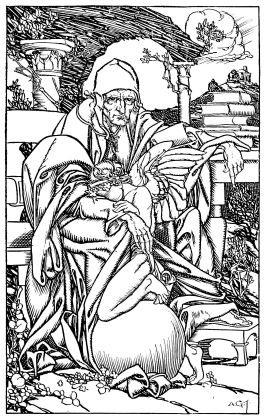
From a drawing by A. Garth Jones
IN MEMORIAM
“Man dies: nor is there hope in dust”
(Reproduced from the Caxton Series Edition of Tennyson’s “In Memoriam,” by kind permission of Messrs. George Newnes, Ltd.)
as representatives of their epoch in the tidiest sense. In some instances, such as Carlyle and Browning and Thackeray, the cause may be an exceptional originality verging upon eccentricity; in others, like George Eliot, it may be allegiance to some particular scheme of thought; in others, like Ruskin and Matthew Arnold, exclusive devotion to some particular mission. In Tennyson, and in him alone, we find the man who cannot be identified with any one of the many tendencies of the age, but has affinities with all. Ask for the composition which of all contemporary compositions bears the Victorian stamp most unmistakably, which tells us most respecting the age’s thoughts{17} respecting itself, and there will be little hesitation in naming “Locksley Hall.”
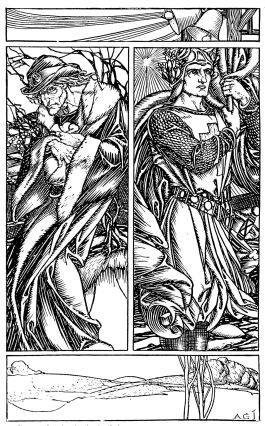
From a drawing by A. Garth Jones
IN MEMORIAM
“Ring out, wild bells, to the wild sky”
(Reproduced from the Caxton Series Edition of Tennyson’s “In Memoriam,” by kind permission of Messrs. George Newnes, Ltd.)
Tennyson returns to his times and what he has received from them, but in an exquisitely embellished and purified condition; he is the mirror in which the age contemplates all that is best in itself. Matthew Arnold would perhaps not have been wrong in declining to recognize Tennyson as “a great and powerful spirit” if “power” had been the indispensable condition of “greatness”; but he forgot that the receptive poet may be as potent as the creative. His cavil might with equal propriety have been aimed at Virgil. In truth, Tennyson’s fame rests upon a securer basis than that of some greater poets, for{18} acquaintance with him will always be indispensable to the history of thought and culture in England. What George Eliot and Anthony Trollope are for the manners of the period, he is for its mind: all the ideas which in his day chiefly moved the elect spirits of English society are to be found in him, clothed in the most exquisite language, and embodied in the most consummate form. That they did not originate with him is of no consequence whatever. We cannot consider him, regarded merely as a poet, as quite upon the level of his great immediate predecessors; but the total disappearance of any of these, except Wordsworth, would leave a less painful blank in our intellectual history than the disappearance of Tennyson.
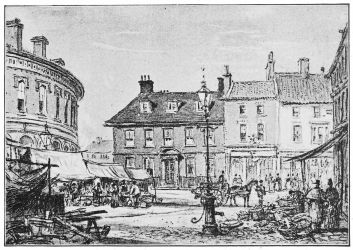
From a drawing by E. Hull
HORNCASTLE
The home of Emily Sellwood, afterwards Lady Tennyson
(Reproduced from “The Laureate’s Country,” by kind permission of Messrs. Seeley & Co., Ltd.)
Beginning, even in his crudest attempts, with a manner distinctly his own, he attained a style which could be mistaken for that of no predecessor (though most curiously anticipated by a few blank-verse lines of William Blake), and which no imitator has been able to rival. What is most truly remarkable is that while much of his poetry is perhaps the most artificial in construction of any in our language, and much again wears the aspect of bird-like spontaneity, these contrasted manners evidently proceed from the same writer, and no one would think of ascribing them to different hands. As a master of blank verse Tennyson, though perhaps not fully attaining the sweetness of Coleridge or the occasional grandeur of Wordsworth and Shelley, is upon the whole the third in our language after Shakespeare and Milton, and, unlike Shakespeare and Milton, he has made it difficult for his successors to write blank verse after him.{20}
Tennyson is essentially a composite poet. Dryden’s famous verses, grand in expression, but questionable in their application to Milton, are perfectly applicable to him: save that, in making him, Nature did not combine two poets, but many. This is a common phenomenon at the close of a great epoch; it is almost peculiar to Tennyson’s age that it should then have heralded the appearance of a new era; and that, simultaneously with the inheritor of the past, perhaps the most original and self-sufficing of all poets should have appeared in the person of Robert Browning. A comparison between these illustrious writers would lead us too far; we have already implied that Tennyson occupies the more conspicuous place in literary history on account of his representative character.
The first important recognition of Tennyson’s genius came from Stuart Mill, who, partly perhaps under the guidance of Mrs. Taylor, evinced{21}
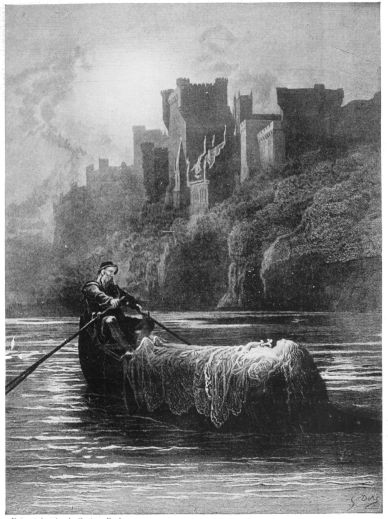
From a drawing by Gustave Doré
ELAINE
(Reproduced from “Illustrations to Tennyson’s ‘Idylls of the King,’” by kind permission of Messrs. Ward, Lock & Co.)
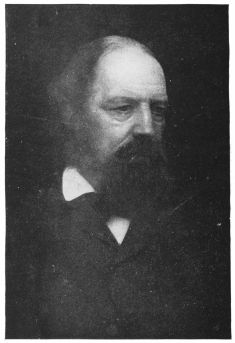
From a photograph in 1867 by Mrs. Julia Margaret Cameron
ALFRED TENNYSON
(Reproduced by permission of Mr. J. Caswall Smith)
about 1835 a remarkable insight into Shelley and Browning as well as Tennyson. In the course of his observations he declared that Tennyson needed to be a great poet was a system of philosophy, to which time would certainly conduct him. If he only meant that Tennyson needed “the years that bring the philosophic mind,” the observation was entirely just; if he expected the poet either to evolve a system of philosophy for himself or to fall under the sway of some great thinker, he was mistaken. Had Tennyson done either he might have been a very great and very interesting poet, but he could not have been the poet of his age; for the temper of the time, when it was not violently partisan, was liberally eclectic. There was no one great leading idea, such as that of evolution in the last quarter of last century, so ample and so characteristic of the age that a poet might become its disciple without yielding to party what was meant for mankind. Two chief currents of thought there were; but they were antagonistic, even though Mr. Gladstone has proved that a very{23}

From the portrait in the possession of Lady Henry Somerset, painted by G. F. Watts, R.A., in 1859
ALFRED TENNYSON
exceptional mind might find room for both. Nothing was more characteristic of the age than the reaction towards medieval ideas, headed by Newman, except the rival and seemingly incompatible gospel of “the railway and the steamship” and all their corollaries. It cannot be said that Tennyson, like Gladstone, found equal room for both ideals in his mind, for until old age had made him mistrustful and querulous he was essentially a man of progress. But his choice of the Arthurian legend for what he intended to be his chief work, and the sentiment of many of his most beautiful minor poems, show what attraction the mediæval spirit also possessed for him; nor, if he was to be in truth the poetical representative of his period, could it have been otherwise. He is not, however, like Gladstone, alternately a mediæval and a modern man; but he uses mediæval sentiment with exquisite judgment to mellow what may appear harsh or crude in the new ideas of political reform, diffusion of education, mechanical invention, free trade, and colonial expansion. The Victorian, in fact,{24}
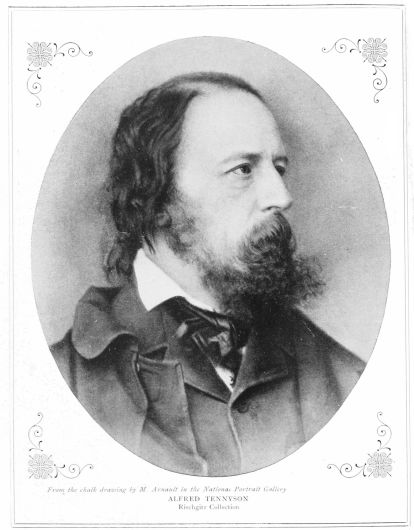
From the chalk drawing by M. Arnault in the National Portrait Gallery
ALFRED TENNYSON
Rischgitz Collection
finds himself nearly in the position of the Elizabethan, who also had a future and a past; and, except in his own, there is no age in which Tennyson would have felt himself more at home than in the age of Elizabeth. He does, indeed, in “Maud” react very vigorously against certain tendencies of the age which he disliked; but this is not in the interest of the mediæval or any other order of ideas incompatible with the fullest development of the nineteenth century. If the utterance here appears passionate, it must be remembered that the poet writes as a combatant. When he constructs, there is nothing more characteristic of him than his sanity. The views on female education propounded in “The Princess” are so sound that good sense has supplied the place of the spirit of prophecy, which did not tabernacle with Tennyson. “In Memoriam” is a most perfect expression of the average theological temper of England in the nineteenth century. As in composition, so in spirit, Tennyson’s writings have all the{26} advantages and all the disadvantages of the golden mean.
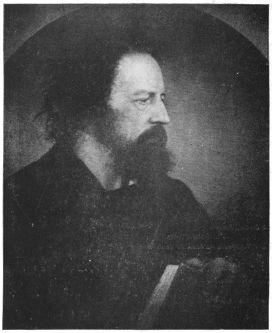
From a photo by Mrs. Julia Margaret Cameron
TENNYSON (About 1871)
(Reproduced by permission of Mr. J. Caswall Smith)
By virtue of this golden mean Tennyson remained at an equal distance from revolution and reaction in his ideas, and equally remote from extravagance and insipidity in his work. He is essentially a man of the new time; he begins his career steeped in the influence of Shelley and Keats, without whom he would never have attained the height he did—a height nevertheless, in our opinion, appreciably below theirs, if he is regarded simply as a poet. But he is a poet and much else; he is the interpreter of the Victorian era—firstly to itself, secondly to the ages to come. Had even any poet of greater genius than himself arisen in his own day, which did not happen, he would still have remained the national poet of the time in virtue of his universality. Some personal friends splendide mendaces have hailed him as our greatest poet since Shakespeare. This is absurd; but it is true that no other poet since Shakespeare has produced a body of{27}
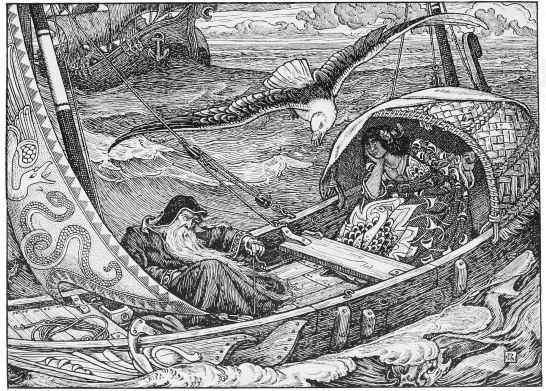
From a drawing by George W. Rhead
MERLIN AND VIVIEN
(Reproduced from the Illustrated Edition of “Idylls of the King,” by kind permission of Messrs. Macmillan & Co., Ltd.)
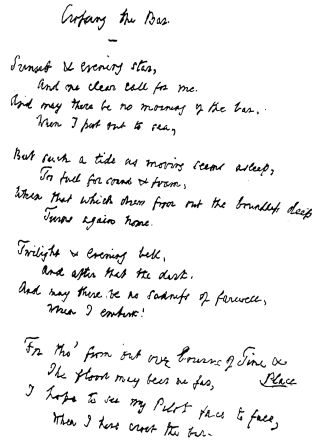
A FACSIMILE TENNYSON’S MANUSCRIPT, “CROSSING THE BAR”
(Reproduced from “Tennyson: A Memoir,” by kind permission of Messrs. Macmillan & Co., Ltd.)
poetry which comes so near to satisfying all tastes, reconciling all tendencies, and registering every movement of the intellectual life of the period. Had his mental balance been less accurately poised, he might have been the laureate of a party, but he could not have been the laureate of the nation. As an intellectual force he is, we think, destined to be powerful and durable, because the charm of his poetry will always keep his ideas before the popular mind; and these{29} ideas will always be congenial to the solid, practical, robust, and yet tender and emotional mind of England. They may be briefly defined as the recognition of the association of continuity with mutability in human institutions: the utmost reverence for the past combined with the full and not regretful admission that
the conception of Freedom as something that “broadens down, from precedent to precedent”; veneration for “the Throne unshaken still,” so long as it continues “broad-based upon the People’s will,” which will always be the case so long as
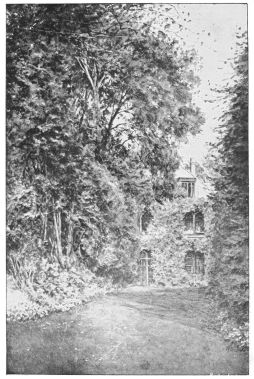
From a water-colour drawing by Mrs. Allingham
THE GLADE AT FARRINGFORD
(Reproduced by kind permission of the Artist)
Philosophically and theologically, Tennyson is even more conspicuously the representative of the average English mind of his{30}
day. Not that he is a fusion of conflicting tendencies, but that he occupies a central position, equally remote from the excesses of scepticism and the excesses of devotion. This position he is able to fill from his relation to Coleridge, the great exponent of the via media: not, as in former days, between Protestantism and Romanism, but between orthodoxy and free thought. Tennyson cannot, indeed, be termed Coleridge’s intellectual heir. As a thinker he is far below his predecessor, and almost devoid of originality; but as a poet he fills up the measure of what was lacking in Coleridge, whose season of speculation hardly arrived until the season of poetry was past. Tennyson was but one of a band of auditors—it might be too much to call them disciples—of the sage who, curiously enough, had himself been a Cambridge man, and who, short and unsatisfactory as had been his residence at that seat of learning,{31}
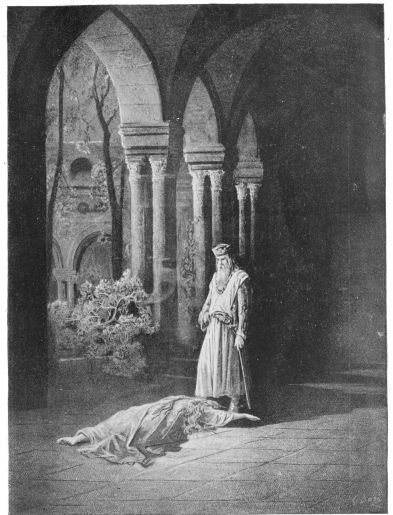
From a drawing by Gustave Doré
GUINEVERE
(Reproduced from the “Illustrations to Tennyson’s ‘Idylls of the King,’” by kind permission of Messrs. Ward, Lock & Co.)
seemed to have left behind him some invisible influence destined to germinate in due time, for all his most distinguished followers were Cantabs. Such another school, only lacking a poet, had flourished at Cambridge in the seventeenth century, and now came up again like long-buried seeds in a newly disturbed soil. The precise value of their ideas may always be matter for discussion; but they exerted without doubt a happy influence by
providing religious minds reverent of the past with an alternative to mere mediævalism, and gently curbing Science in the character she sometimes assumes of “a wild Pallas of the brain.” When the natural moodiness of Tennyson’s temperament is considered, the{34} prevalent optimism of his ideas, both as regards the individual and the State, appears infinitely creditable to him. These are ideas natural to sane and reflecting Englishmen, unchallenged in quiet times, but which may be obscured or overwhelmed in seasons of great popular excitement. The intellectual force of Tennyson is perhaps chiefly shown in the art and attractiveness with which they are set forth; even much that might have appeared tame or prosaic is invested with all the charms of imagination, and commends itself to the poet equally with the statesman. Tennyson is not the greatest of poets, but appreciation of his poems is one of the surest criteria of poetical taste; he is not one of the greatest of thinkers, but agreement with his general cast of thought is an excellent proof of sanity; many singers have been more Delphic in their inspiration, but few, by maxims of temperate wisdom, have provided their native land with such a Palladium.
Richard Garnett.
Somersby Rectory, the birthplace of Alfred Tennyson
see page 3
Alfred Tennyson was born on Sunday, August 6th, 1809, at Somersby, a village in North Lincolnshire between Horncastle and Spilsby. His father, the Rev. Dr. George Clayton Tennyson, Rector of Somersby, married in 1805 Elizabeth Fytche, daughter of the Vicar of Louth, in the same county; and, of their twelve children, Alfred was the fourth.
Somersby Brook
see page 1
He always spoke with affectionate remembrance of his early home: of the woodbine trained round his nursery window; of the mediæval-looking dining-hall, with its pointed stained-glass casements; of the pleasant drawing-room, lined with bookshelves and furnished with yellow upholstery. The lawn in front of the house, where he composed his early poem, “A Spirit Haunts the Year’s Last Hours,” was overshadowed on one side by wych-elms, on the other by larch and sycamore trees. On the south was a path bounded by a flower-border, and beyond “a garden bower’d close” sloping gradually to the field at the bottom of which ran the Somersby Brook
The charm and beauty of this brook haunted the poet throughout his life, and to it he especially dedicated, “Flow down, cold rivulet, to the sea.” Tennyson did not, however, attribute his famous poem, “The Brook,” to the same source of inspiration, declaring it was not addressed to any stream in particular.
Tennyson’s Mother
see page 6
Tennyson was exceedingly fortunate in the environment of his childhood and the early influence exercised by his parents. His mother was of a sweet and gentle disposition, and devoted herself entirely to the welfare of her husband and her children. Her son is said to have taken her as a model in “The Princess”; and he certainly gave a more or less truthful description of this “remarkable and saintly woman” in his poem “Isabel”:—
Somersby Church
see page 4
Tennyson’s father was a man of marked physical strength and stature, called by his parishioners “The stern Doctor.” In 1807 he was appointed to the living of Somersby, and that of the adjoining village of Bag Enderby, and this position he held until his death, on March 16th, 1831, at the age of fifty-two. He was buried in the old country churchyard, where “absolute stillness reigns,” beneath the shade of the rugged little tower. In his time the roof of the church was covered with thatch, as were also those of the cottages in its immediate vicinity.
Bag Enderby Church
see page 6
The livings of Somersby and Bag Enderby were held conjointly, service being conducted at one church in the morning and at the other in the afternoon. Dr. Tennyson read his sermons at Bag Enderby from the quaint high-built pulpit, Alfred listening to them from the squire’s roomy pew.
Louth
see page 4
The Grammar School, Louth
see page 7
At the age of seven Tennyson was sent to school at Louth, a market-town which may fairly lay claim to having been a factor of some importance in his early life. His maternal grandmother lived in Westgate Place, her house being a second home to the young Tennysons. The old Grammar School where Alfred received the early portion of his education is now no longer in existence. Tennyson’s recollections of it and of the Rev. J. Waite, at that {37}time the head-master, were not pleasant. “How I did hate that school!” he wrote later. “The only good I got from it was the memory of the words Sonus desilientis aquæ, and of an old wall covered with wild weeds opposite the school windows.”
Tennyson’s first connected poems were composed at Louth, and in this town also his first published work saw the light, appearing in a volume entitled “Poems by Two Brothers,” issued in 1827 by Mr. J. Jackson, a bookseller. The two brothers were Charles and Alfred Tennyson.
After a school career which lasted four years, Alfred returned to Somersby to continue his studies under his father’s tuition. This course of instruction was supplemented by classics at the hands of a Roman Catholic priest, and music-lessons given him by a teacher at Horncastle.
In 1828 Charles and Alfred Tennyson followed their elder brother Frederick to Trinity College, Cambridge. They began their university life in lodgings at No. 12, Rose Crescent, moving later to Trumpington Street, No. 57, Corpus Buildings. Of his early experiences of life at Cambridge, Alfred wrote to his aunt: “I am sitting owl-like and solitary in my rooms (nothing between me and the stars but a stratum of tiles). The hoof of the steed, the roll of the wheel, the shouts of drunken Gown and drunken Town come up from below with a sea-like murmur.... The country is so disgustingly level, the revelry of the place so monotonous, the studies of the University so uninteresting, so much matter of fact. None but dry-headed, calculating, angular little gentlemen can take much delight in them.”
Arthur Hallam (from the bust by Chantrey)
see page 8
It was at Trinity College that Tennyson first made the acquaintance of Arthur Hallam, youngest son of the historian, whose friendship so profoundly influenced the poet’s character and genius. “He would have been known if he had lived,” wrote Tennyson, “as a great man, but not as a great poet; he was as near perfection as mortal man could be.”
The Lady of Shalott
see page 10
In February 1831 Tennyson left Cambridge without taking a degree, and returned to Somersby, his father dying within a month of his arrival. From this time onward Hallam became an intimate visitor at the Rectory, and formed an attachment for his friend’s sister Emily. In July 1832 Tennyson and Hallam went touring on the Rhine, and at the close of the year appeared the volume of “Poems by Alfred Tennyson,” which contained, amongst others, “The Lady of Shalott,” “The Miller’s Daughter,” “The Palace of Art,” “The Lotos Eaters,” and “A Dream of Fair Women.”
“Well I remember this poem,” wrote Fitzgerald, with reference to “The Lady of Shalott,” “read to me, before I knew the author, at Cambridge one night in 1832 or 3, and its images passing across my head, as across the magic mirror, while half asleep on the mail-coach to London ‘in the creeping dawn’ that followed.”
The idea of “Mariana in the South” came to Tennyson as he was{38}
“Mariana in the South”
see page 13
travelling between Narbonne and Perpignan. Hallam interpreted it to be the “expression of desolate loneliness.”
Stockworth Mill
see page 14
Of these earlier poems none added more to Tennyson’s growing reputation than “The Miller’s Daughter.” It was probably written at Cambridge, and the poet declared that the mill was no particular mill, or if he had thought of any mill it was that of Trumpington, near Cambridge. But various touches in the poem seem to indicate that the haunts of his boyhood were present in his mind.
Stockworth Mill was situated about two miles along the banks of the Somersby Brook, the poet’s favourite walk, and might very well have inspired the setting of these beautiful verses.
The Palace of Art
see page 11
In the volume of 1832, several stanzas of “The Palace of Art” were omitted, because Tennyson thought the poem was too full. “‘The Palace of Art,’” he wrote in 1890, “is the embodiment of my own belief that the Godlike life is with man and for man.”
Amongst the “marvellously compressed word pictures” of this poem is the beautiful one of our illustration on page 11.
Clevedon Church
see page 14
On the 15th of September, 1833, Arthur Hallam died suddenly at Vienna. His remains were brought to England, and laid finally to rest in the old and lonely church beside the sea at Clevedon, on January 3rd, 1834.
Tennyson’s whole thoughts were absorbed in memories of his friend, and he continually wrote fragmentary verses on the one theme which filled his heart, many of them to be embodied seventeen years later in the completed “In Memoriam.”
The home of Emily Sellwood, at Horncastle
see page 19
In 1830 Tennyson first met Emily Sellwood, who twenty years later became his wife. Horncastle was the nearest town to Somersby, and in the picturesque old market-square stood the red-brick residence of Mr. Henry Sellwood, a solicitor. The young Sellwoods being much of the same age as the Tennysons, a friendship sprang up between the two families, which in later{39}
Grasby Church
see page 20
years ripened into a double matrimonial relationship. In 1836, Charles Tennyson, the poet’s elder brother, married Louisa, the youngest daughter of Henry Sellwood. In the previous year he had succeeded to the estate and living of Grasby, taking the surname of Turner under his great-uncle’s will. At his own expense he built the vicarage, the church and the schools; and on his death, in 1879, Grasby descended to the Poet Laureate. It was at his brother’s wedding that the bride’s sister, Emily, was taken into church by Alfred Tennyson, but no engagement was recognised between them until four or five years later, and their marriage did not take place until 1850. It was solemnised at Shiplake Church on June 13th, the clergyman who officiated being the poet’s intimate friend, the Rev. Robert Rawnsley.
In the April of the same year, on the death of Wordsworth, Tennyson had been offered the poet-laureateship, to which post he was appointed on November 19th, owing chiefly to Prince Albert’s admiration for “In Memoriam.”
Lady Tennyson
see page 18
Lady Tennyson became the poet’s adviser in literary matters. “I am proud of her intellect,” he wrote. She, with her “tender, spiritual nature,” was always by his side, cheerful, courageous, and a sympathetic counsellor. She shielded his sensitive spirit from the annoyances and trials of life and “her faith as clear as the heights of the June-blue heaven” helped him in hours of depression and sorrow.
Chapel House, Twickenham
see page 20
Chapel House, Twickenham, was the poet’s first settled home after his marriage, and he resided in it for three years. It was here his “Ode on the Death of the Duke of Wellington” was written, and the birth of his son Hallam took place in this house on August 11th, 1852.
Farringford, Tennyson’s residence at Freshwater
see page 25
In 1853, whilst staying in the Isle of Wight, Tennyson heard that the residence called Farringford was to let at Freshwater. He decided to take the place on lease, but two years later purchased it out of the proceeds resulting from “Maud,” which was published in 1855, and Farringford remained his home during the greater part of each year for forty years, and here he wrote some of his best-known works.
“The house at Farringford,” says Mrs. Richmond Ritchie in her Records, “seemed like a charmed palace, with green walls without, and speaking walls within. There hung Dante with his solemn nose and wreath; Italy gleamed over the doorways; friends’ faces lined the passages, books filled the shelves, and a glow of crimson was everywhere; the oriel drawing-room window was full of green and golden leaves, of the sound of birds and of the distant sea.”
The Glade at Farringford
see page 29
The grounds of Farringford are exceedingly beautiful and picturesque. On the south side of the house is the glade, and close by
Referring to Farringford in his invitation to Maurice, Tennyson wrote—
The ridge of the down in question constituted the poet’s favourite walk, and{40}
Freshwater Bay
see page 30
the scenery which he encountered round Freshwater Bay might well have been represented in the opening verse of “Enoch Arden”—
Freshwater Village
see page 30
Inland the road leads to the little village of Freshwater, in which the erection of a number of new houses evoked from the poet the lines—
Opposite these villas stands an ivy-clad house at that time occupied by Mrs. Julia Cameron, the celebrated lady art-photographer, two of whose effective portraits of Tennyson appear on pages 22 and 26.
Aldworth
see page 33
In the autumn of 1859, “The Idylls of the King” were first issued in their original form, being four in number: Enid, Vivien, Elaine, and Guinevere, and from their publication until the end of Tennyson’s life his fame and popularity continued without a check. During the next few years the poet spent much time in travelling, but in 1868 he laid the foundation-stone of a new residence, named Aldworth, about two miles from Haslemere, which became his second home—
Tennyson’s Lane
see page 33
On the way from Haslemere to Aldworth, it is necessary to cross a rough common covered with whin bushes to reach the long winding lane which was named Tennyson’s Lane. This was the poet’s favourite walk when living in the neighbourhood.
Tennyson’s Memorial, Beacon Hill, Freshwater
see page 34
Tennyson died on Thursday, October 6th, 1892, and was buried in the Poets’ Corner, Westminster Abbey, next to Robert Browning, and near the Chaucer monument. Against the pillar close by the grave has been placed Woolner’s well-known bust. The monument erected to the memory of the poet on Beacon Hill, near Freshwater, was unveiled by the Dean of Westminster on August 6th, 1897.
Alfred Tennyson (from the painting by Samuel Laurence)
see page 5
With regard to the portraits of Tennyson reproduced in these pages, perhaps those of chief interest in addition to the Cameron photographs already referred to are the paintings by Samuel Laurence, executed about 1838, and the three-quarter length by G. F. Watts, now in the possession of Lady Henry Somerset. Of the former Fitzgerald wrote:
“Very imperfect as Laurence’s portrait is, it is nevertheless the best painted portrait I have seen; and certainly the only one of old days. ‘Blubber-lipt’ I remember once Alfred called it; so it is; but still the only one of old days, and still the best of all, to my thinking.”
Alfred Tennyson (from the painting by G. F. Watts in 1859)
see page 23
The Watts portrait, according to Mr. Watts-Dunton, possesses “a certain dreaminess which suggests the poetic glamour of moonlight.” The same writer asserts that “while most faces gain by the artistic halo which a painter of genius always sheds over his work, there are some few, some very few faces that do not, and of these Lord Tennyson’s is the most notable that I have ever seen among men of great renown.”